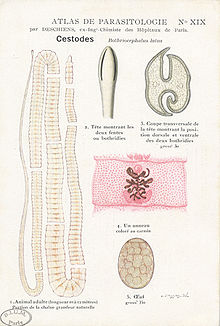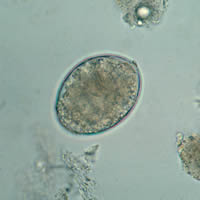Diphyllobothriasis
| Classification according to ICD-10 | |
|---|---|
| B70.0 | Diphyllobothriosis - infection by the adult form of Diphyllobothrium (latum) (pacificum) |
| B70.1 | Sparganose - infestation by Diphyllobothrium larvae |
| ICD-10 online (WHO version 2019) | |
The diphyllobothriasis is a disease caused by the infestation of humans with the fish tapeworm or pit head ( Diphyllobothrium latum is caused). The infection occurs through the consumption of raw or insufficiently heated fish. The infection is often asymptomatic and unnoticed, but can lead to clinical symptoms with megaloblastic anemia and neurological symptoms.
etiology
The fish tapeworm lives as an adult worm in humans , dogs , cats , bears and other fish-eating mammals . This fish tapeworm is the largest parasite in humans and can reach a length of up to 20 m. The link chains have a width of 10-25 mm. Empty proglottids (individual body sections of the tapeworm), which are often up to 1 m in length, are often given off with the stool. The parasite belonging to the Pseudophyllidaea has two elongated suction pits as a fastening organ on the side of the scolex . In contrast to the cyclophyllids , the pseudophyllids on the proglottids have a flat genital pore. In addition to infection with Diphyllobothrium latum , infections with other species of the genus Diphyllibotrium also occur less frequently , for example with D. dentriticum on the coasts of Alaska , North and South America ( Andean region ), D. pacificum on the Pacific coast of South America and the D. nihonkaiense in Japan . However, diphyllobothriasis as a clinical disease is mostly caused by Diphyllobothrium latum .
Occurrence and distribution
The endemic areas include in particular the Baltic Sea , Switzerland and Russia . Even Ireland , Italy , France , the Danube Delta , North America (lake areas), Alaska, several Asian countries, Papua New Guinea and Australia are considered endemic . On the coasts of Peru and Chile is Diphyllobothrium pacificum home. The infection occurs sporadically in Japan. The infested fish can be numerous species of brackish or freshwater fish, because only these two groups can come into sufficient contact with corresponding small crustaceans that have been contaminated by human feces containing tapeworms . This particularly affects stretches of coast into which human feces are discharged.
transmission
The life cycle is similar for all Diphyllobotrium species. The adult worms in the intestine secrete unembryonated eggs, which are then excreted in the stool. If the eggs get into fresh or brackish water , a buoyant hook larva develops in them . If the hook larva of copepods (copepods) was added, develops in them from the Onkosphäre the Prozerkoid larva. These small crustaceans are in turn eaten by coarse fish , in whose muscles the plerozerkoid develops from the procercoid . The larval type , then known as Sparganum , accumulates in predatory fish when they eat the non- predatory fish. When humans consume raw fish meat, the plerozerkoids are then ingested. In the USA, diphyllobothriasis was also called Jewish or Scandinavian housewife's disease , because the traditional cuisine of both immigrant groups consists of fish preparations made from seasoned fish farce ( gefilte fish , Fiskeboller ), and the housewives became infected while tasting the raw fish farce . The plerozerkoids develop into adult worms in the human intestine. The worm's daily growth in the intestine is 9 to 15 cm. After 3 to 5 weeks, the worms become sexually mature and begin to produce eggs. The parasite can persist in the intestine for up to 25 years.
clinic
In most cases, fish tapeworm infestation remains without symptoms . Macrocytic anemia develops as a result of the withdrawal of vitamin B12 in only about 2% of those infected . General symptoms are fatigue and dizziness, abdominal pain and diarrhea. In isolated cases, cholecystitis and cholangitis can occur. If the infestation remains undetected for a long time, neurological complaints with abnormal sensations ( paresthesia ), disturbances in the sensation of vibration ( pallhypesthesia ), motor disturbances ( paresis ) and atrophy of the optic nerve can occur.
Diagnosis
The diagnosis of diphyllobothriasis done by the detection of proglottids in the stool, which can be done with the naked eye. The fish tapeworm eggs are also found microscopically in the stool. They are thick-shelled, capped and measure 45 x 70 µm.
therapy
The agents of choice for therapy are praziquantel (5–10 mg / kg body weight per os), which is administered once, or niclosamide (1 x 2 g). Mebendazole can also be used. A control examination of the stool after 6 to 8 weeks is important. The vitamin B12 deficiency is treated parenterally .
prophylaxis
The most important prophylactic measure is avoiding the consumption of raw or undercooked fish. In addition to raw or raw marinated fish, sushi and oysters are potentially endangered foods . By freezing the fish meat for at least 1 week at -18 ° C, the Plerozerkoiden in meat can kill. Therefore it is safe to eat frozen fish.
Reporting requirement
Diphyllobothriasis is not notifiable under the Infection Protection Act.
literature
- Hartmut Krauss, Albert Weber, Burkhard Enders a. a .: Zoonoses: infectious diseases that can be transmitted from animal to human . 3rd, completely revised and updated edition. Deutscher Ärzte-Verlag, Cologne 2004, ISBN 3-7691-0406-4 , p. 439 ff
Individual evidence
- ↑ BBB - Diphyllobothrium spp. US Food and Drug Administration (English). Retrieved February 12, 2010



